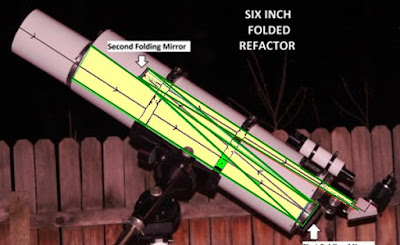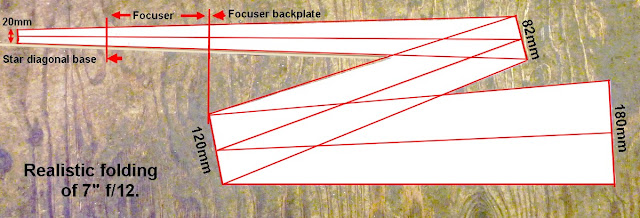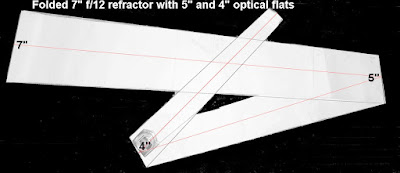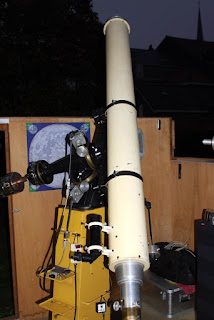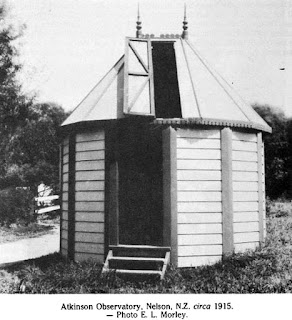*
One question which crops up often is: Should one "invest" in a more compact APO of the same aperture?
Rather than "enjoying" the difficulty and expense of building [or
buying commercially] a
folded, long focus refractor? Only a very long focus achromat can
possibly compete on colour correction with an Apo. If taken to its
natural limits would result in an extraordinarily long focal length.
F/20 and well beyond is demanded by Conrady's far stricter CA limits of a CA-ratio >5. [CA ratio = Focal Ratio /aperture in inches.] f/30 / 6" = 5 falls just within his stringent criteria. Whereas Sidgwick suggests that f/18 / 6" = 3 is an acceptable level of colour correction for this popular size of refractor. It seems odd that most 6" classical style refractors are f/15 with an f/12 option. Those who, like me, own an f/8 must just try to ignore all the "pretty colours." The usual effect of relaxing CA-ratios is a purple fringe around bright objects where blue and red are not focused in the same plane. Tolerance of violet fringing is remarkably variable between telescope users and can be seeing-dependent. Older observers tend to have some yellowing of their own eye lenses which can act as filters to some extent. Yellow No8 filters are still a popular way of reducing CA even after the arrival of multi-layer filters like the Fringe Killer. Though it should always be remembered that filters work by removing unwanted light. While Apos add that light to their images by bending more colours to a common focus. The image seen through an apochromat telescope is usually more cosmetically attractive than through an achromat. The apochromat should have a brighter image too which may offer greater "reach" into low-brightness subjects and limiting magnitudes.
You can't have your short focus refractor cake and eat it when it comes to chromatic aberration. The builder or buyer must ask whether the cost of the precision optical flats can be "written off" against the [sometimes considerable] savings from using a much smaller mounting when a suitably long focus lens is folded optically. Not to mention savings from a smaller housing for either instrument compared with the long, straight achromatic refractor. The APO may claim to be free of false colour, in comparison with an achromat, but has other drawbacks or limitations. Some of which are still so serious as to preclude mass adoption.[Price being the major drawback!]
The cost of larger APOs rises almost exponentially above six inches aperture. Which makes them very poor value compared with a simpler, achromatic refractor. [Or a simple Newtonian reflector which is completely free of false colour!] There are relatively few commercial apochromats over about 180mm/7" aperture. So economies of scale in mass production never arise. The glass remains difficult and expensive to obtain because there is literally almost no demand for large melts from which to extract suitably large blanks. Then there is the matter of fragility of some exotic glasses. Some can suffer from breakage due to thermal shock and others are slightly water absorbent. Absolute longevity in use might be an issue with some types of glass. We tend to think of refractors as lasting for centuries.
Apos [apochromats] often have cooling issues in triplet form due to the large mass of glass involved. The center element is not even exposed to the air on either side so is effectively insulated by the outer lens elements. "Oiling" may help to increase conduction but does not reduce the overall mass. The sheer weight and nose-heaviness of a triplet APO is another disadvantage. The moment arm will usually demand a sturdy [expensive] mounting. Steep curvature might be necessary for short focus lenses resulting in extra thick lens elements compared with the more "humble" achromat.
Meanwhile, the very long focus achromat [for inherently low false colour] will have a much smaller field of view than the short focus Apo. Though the long focus automatically provides high powers with longer focus eyepieces providing comfortable eye relief. Which might be more important to potential Apo-owning, spectacle wearers unless they can also afford exotic eyepieces which offer good eye relief. Exotic [expensive] eyepieces will be necessary with short focus Apos anyway. While long focus refractors are very forgiving and will work well with almost any eyepiece.
 Folded 7" f/12 using minimum 122mm and 82mm folding optical flats. The focuser is now above the OTA body to reduce overall length and its vulnerability during carriage. The bend in the light cone at the star diagonal is also indicated. The angles at the mirrors have been widened to reduce the risk of stray light by ensuring complete baffling is possible. A roughly drawn suggestion of a possible plywood case is also shown.
Folded 7" f/12 using minimum 122mm and 82mm folding optical flats. The focuser is now above the OTA body to reduce overall length and its vulnerability during carriage. The bend in the light cone at the star diagonal is also indicated. The angles at the mirrors have been widened to reduce the risk of stray light by ensuring complete baffling is possible. A roughly drawn suggestion of a possible plywood case is also shown.Sacrificing the image quality of a fine achromatic lens with inferior optical flats is really not sensible. It might seem like an easy short cut to Apo-like correction. But it is very risky just to obtain the mechanical mounting and smaller housing advantages of an APO of similar aperture. The Apo might be more useful on Deep Sky observations while the very long focus achromat is better suited to the visual study of Solar System objects. An Apo will usually require considerable amplification of the image size [using Barlow lenses] before a planet will register more than a few pixels on the camera sensor. While the long focus achromat already has magnification aplenty to provide suitable image scale.
Poly-chromatism refers to the difference in lens accuracy/correction measured at various wavelengths of light. This is why long focal length achromats are much preferred to reduce the effects of achromatic aberration to as low a level as possible. Long focal lengths are also claimed to be far more forgiving during poor seeing conditions. Unfortunately the heavy lens and its cell mounted at the far end of a long, straight tube make the "classical" refractor inevitably unwieldy. It is very difficult to mount adequately due to the effective moment arm. Fortunately, folding the very long optical path can eliminate many of the usual mounting and housing problems by considerably reducing the moment arm and OTA length.
Moment arm = Mass x Distance from the fulcrum. Or distance of the heavy objective, cell and counter-cell assembly from the mounting bearings in the real world. A heavy focuser and back plate will add their own mass x distance to the overall moment arm. They may help to balance the objective but will still contribute to the moment arm ]
The folded refractor can often reduce the moment arm to [probably] 1/3rd of the straight tube form. Allowing even longer focal lengths to be more easily accommodated on rather more "humble" [i.e. cheaper] mountings. The very high cost of even secondhand AP1200 mountings can be safely avoided by folding a "long" straight refractor. It will then fit more safely on a Skywatcher class of mounting. Those who can afford an Astro-Physics mounting will still enjoy the shorter, folded refractor over the straight "long" version.
 The image shows Dave Trott standing beside his folded Unitron [on the far
right] and his own, superb, folded 6" f15 refractor. Even with the
dewshield in place it is obvious how much shorter both these instruments are
compared with the incredibly long, classical, straight tubed originals.
The image shows Dave Trott standing beside his folded Unitron [on the far
right] and his own, superb, folded 6" f15 refractor. Even with the
dewshield in place it is obvious how much shorter both these instruments are
compared with the incredibly long, classical, straight tubed originals.With a 6" f/15 refractor: Focal length = 90" or 8'6" [2.25meters] plus dewshield length. Dave Trott has built a couple of folded refractors. He has obtained valuable "hands on" experience which he has shared online: Dave Trott is also responsible for lots of interesting YouTube videos mostly on classical or 'vintage' telescopes. The image is "borrowed" from Dave Trott's website and is reproduced here for educational purposes. Hopefully his fine example will inspire others to investigate and build their own folded refractors.
Constructing a Folded Refractor - DaveTrott.com
https://www.youtube.com/channel/Dave Trott/videos
Websites illustrating folded refractors:
Multiple examples [German language] : Faltrefraktoren.pdf
Use a website translation service if necessary.
An open 'spar' design: Teleskope - VR VR 150/3000
TMB 9" f/9 Triplet APO Folded Refractor - IceInSpace
It is interesting that Peter Wise uses the folded refractor design for his f/12 8" "Zerochromat." This is a form of Dialyte telescope utilizing a singlet, long focus objective lens. It's claim to being close to an apochromat is achieved with two folding mirrors and smaller correction lenses placed in front of the focuser. It's cost is quite competitive compared with similar sized, commercial, achromatic refractor OTAs [with far more false colour] and very much cheaper than true Apochromats of the same aperture. It is also much lighter with fewer objective cooling problems in comparison with a true APO triplet. Allowing it to be mounted on the larger Skywatcher equatorials of relatively modest price.
REFRACTING TELESCOPES FROM ZEROCHROMAT - HOME
https://www.youtube.com/channel/Dave Trott/videos
Websites illustrating folded refractors:
Multiple examples [German language] : Faltrefraktoren.pdf
Use a website translation service if necessary.
An open 'spar' design: Teleskope - VR VR 150/3000
TMB 9" f/9 Triplet APO Folded Refractor - IceInSpace
It is interesting that Peter Wise uses the folded refractor design for his f/12 8" "Zerochromat." This is a form of Dialyte telescope utilizing a singlet, long focus objective lens. It's claim to being close to an apochromat is achieved with two folding mirrors and smaller correction lenses placed in front of the focuser. It's cost is quite competitive compared with similar sized, commercial, achromatic refractor OTAs [with far more false colour] and very much cheaper than true Apochromats of the same aperture. It is also much lighter with fewer objective cooling problems in comparison with a true APO triplet. Allowing it to be mounted on the larger Skywatcher equatorials of relatively modest price.
REFRACTING TELESCOPES FROM ZEROCHROMAT - HOME
Click on any image for an enlargement.
*
